Analysis of Nutritional Quality in Whole Grain and Refined Flour Foods
VerifiedAdded on 2023/04/06
|15
|3252
|94
Essay
AI Summary
This essay provides a comprehensive analysis of the nutritional quality of foods made from whole grains versus refined flour, highlighting the impact of food processing on nutrient content. Whole grains, containing the bran, germ, and endosperm, offer essential vitamins, minerals, and dietary fiber, which are often lost during the refining process that primarily leaves only the starchy endosperm. The essay discusses how food processing techniques like milling, blanching, canning, and pasteurization can degrade nutritional value by reducing vitamins, minerals, and fiber content, even with fortification efforts. It further explores the advantages and disadvantages of both whole grain and refined flour foods, emphasizing the health benefits of whole grains in reducing risks of diabetes, heart disease, and certain cancers. The document also examines how food processing affects the chemistry of grains, altering carbohydrate and micronutrient content, and concludes by advocating for the inclusion of more whole grains in diets to improve overall health, as supported by dietary guidelines and research findings. Desklib provides access to this essay and other study resources.
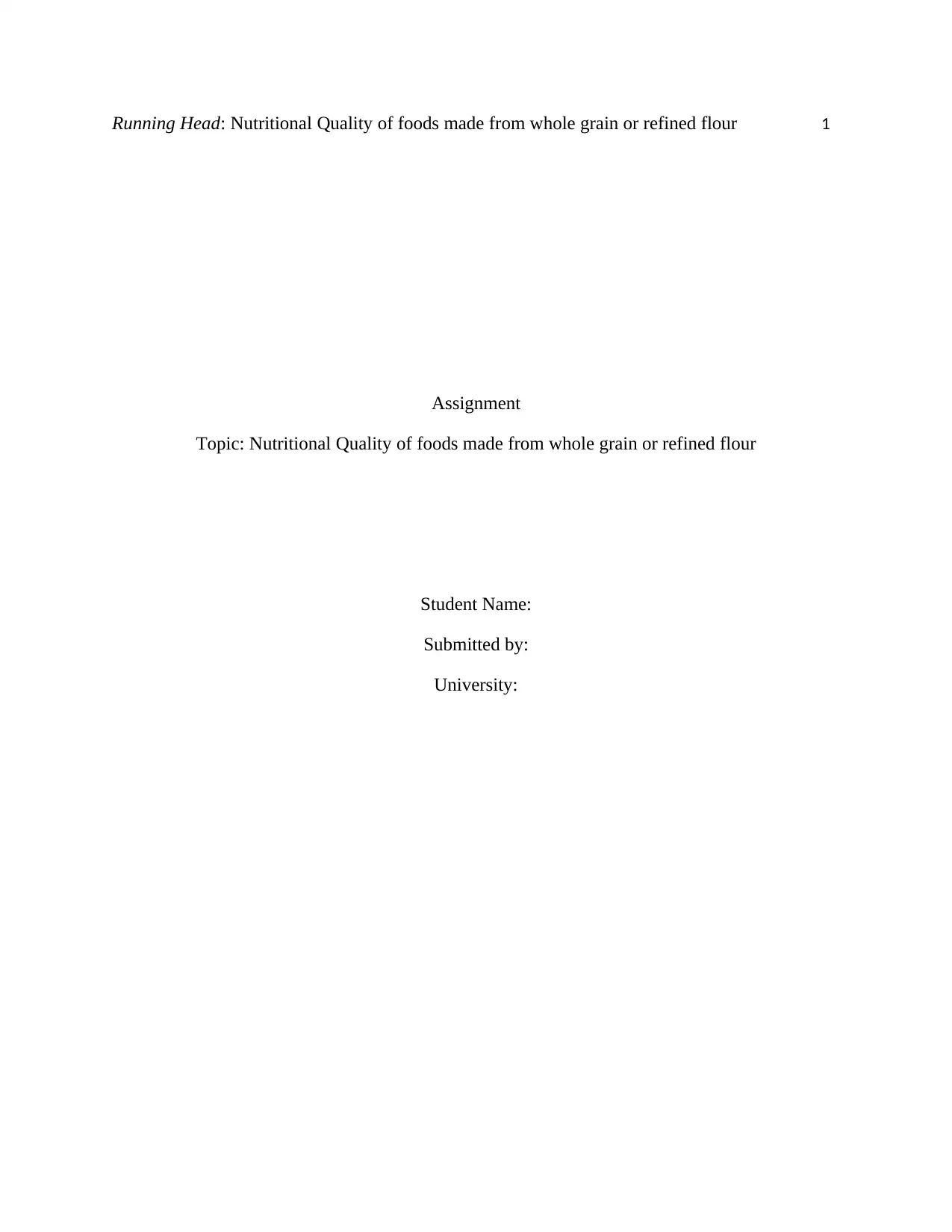
Running Head: Nutritional Quality of foods made from whole grain or refined flour 1
Assignment
Topic: Nutritional Quality of foods made from whole grain or refined flour
Student Name:
Submitted by:
University:
Assignment
Topic: Nutritional Quality of foods made from whole grain or refined flour
Student Name:
Submitted by:
University:
Paraphrase This Document
Need a fresh take? Get an instant paraphrase of this document with our AI Paraphraser
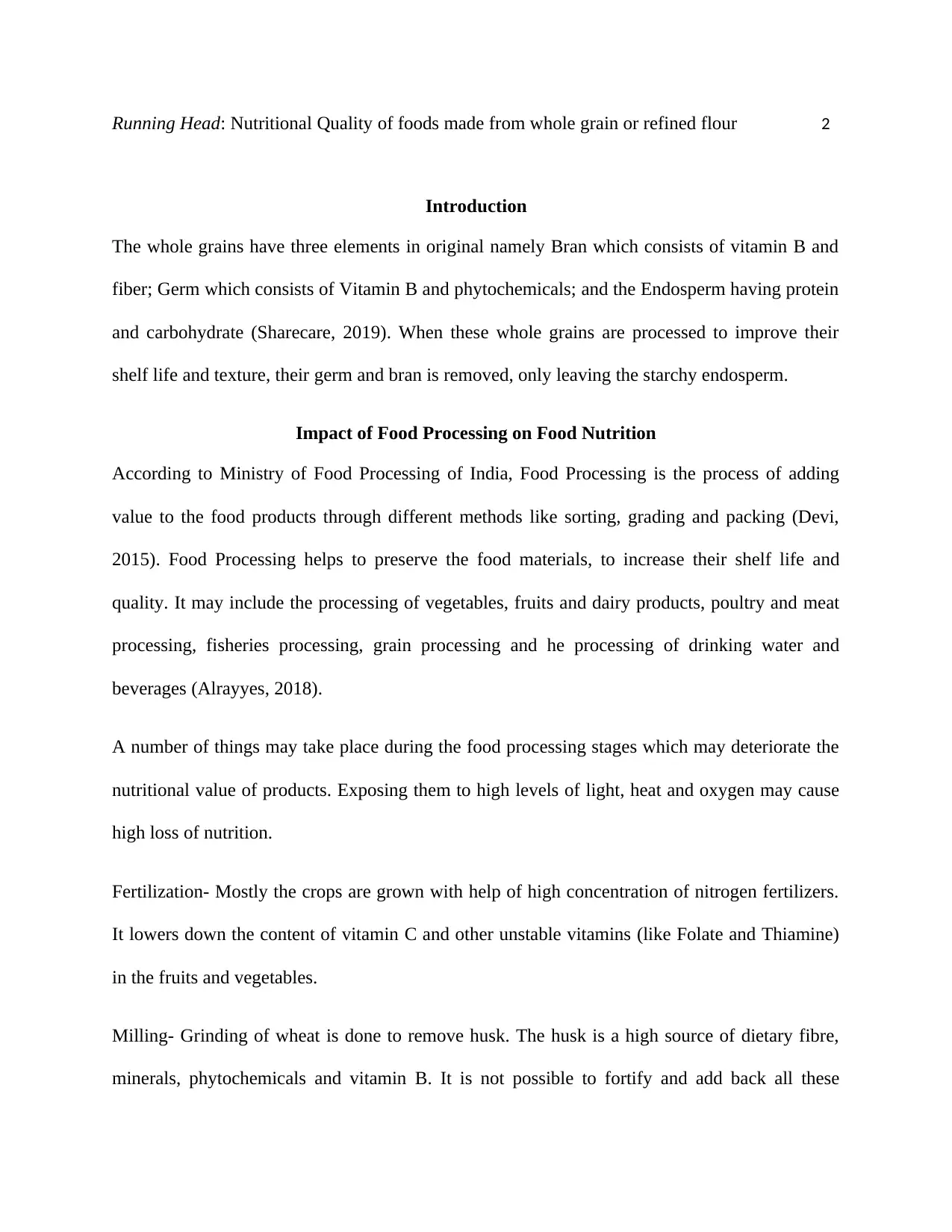
Running Head: Nutritional Quality of foods made from whole grain or refined flour 2
Introduction
The whole grains have three elements in original namely Bran which consists of vitamin B and
fiber; Germ which consists of Vitamin B and phytochemicals; and the Endosperm having protein
and carbohydrate (Sharecare, 2019). When these whole grains are processed to improve their
shelf life and texture, their germ and bran is removed, only leaving the starchy endosperm.
Impact of Food Processing on Food Nutrition
According to Ministry of Food Processing of India, Food Processing is the process of adding
value to the food products through different methods like sorting, grading and packing (Devi,
2015). Food Processing helps to preserve the food materials, to increase their shelf life and
quality. It may include the processing of vegetables, fruits and dairy products, poultry and meat
processing, fisheries processing, grain processing and he processing of drinking water and
beverages (Alrayyes, 2018).
A number of things may take place during the food processing stages which may deteriorate the
nutritional value of products. Exposing them to high levels of light, heat and oxygen may cause
high loss of nutrition.
Fertilization- Mostly the crops are grown with help of high concentration of nitrogen fertilizers.
It lowers down the content of vitamin C and other unstable vitamins (like Folate and Thiamine)
in the fruits and vegetables.
Milling- Grinding of wheat is done to remove husk. The husk is a high source of dietary fibre,
minerals, phytochemicals and vitamin B. It is not possible to fortify and add back all these
Introduction
The whole grains have three elements in original namely Bran which consists of vitamin B and
fiber; Germ which consists of Vitamin B and phytochemicals; and the Endosperm having protein
and carbohydrate (Sharecare, 2019). When these whole grains are processed to improve their
shelf life and texture, their germ and bran is removed, only leaving the starchy endosperm.
Impact of Food Processing on Food Nutrition
According to Ministry of Food Processing of India, Food Processing is the process of adding
value to the food products through different methods like sorting, grading and packing (Devi,
2015). Food Processing helps to preserve the food materials, to increase their shelf life and
quality. It may include the processing of vegetables, fruits and dairy products, poultry and meat
processing, fisheries processing, grain processing and he processing of drinking water and
beverages (Alrayyes, 2018).
A number of things may take place during the food processing stages which may deteriorate the
nutritional value of products. Exposing them to high levels of light, heat and oxygen may cause
high loss of nutrition.
Fertilization- Mostly the crops are grown with help of high concentration of nitrogen fertilizers.
It lowers down the content of vitamin C and other unstable vitamins (like Folate and Thiamine)
in the fruits and vegetables.
Milling- Grinding of wheat is done to remove husk. The husk is a high source of dietary fibre,
minerals, phytochemicals and vitamin B. It is not possible to fortify and add back all these
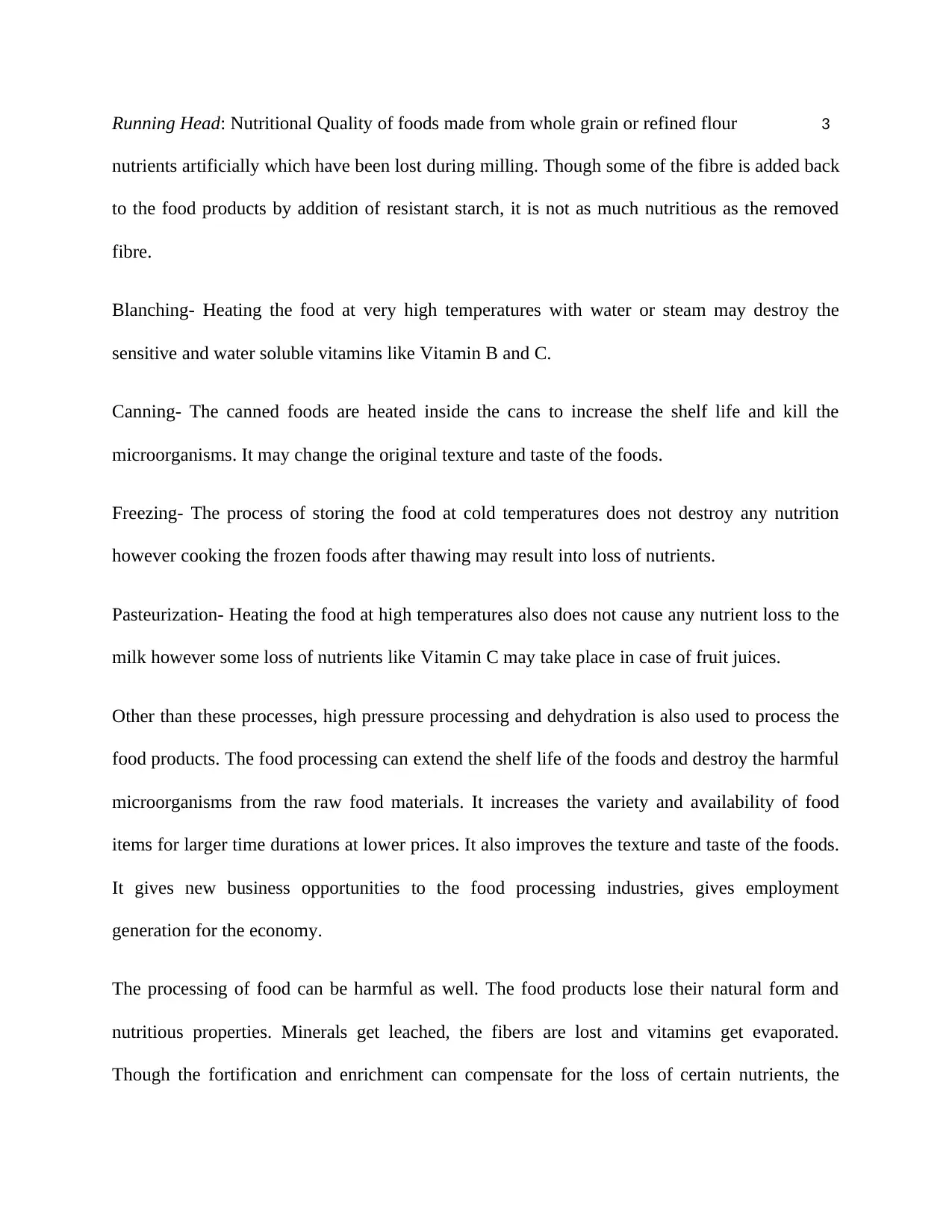
Running Head: Nutritional Quality of foods made from whole grain or refined flour 3
nutrients artificially which have been lost during milling. Though some of the fibre is added back
to the food products by addition of resistant starch, it is not as much nutritious as the removed
fibre.
Blanching- Heating the food at very high temperatures with water or steam may destroy the
sensitive and water soluble vitamins like Vitamin B and C.
Canning- The canned foods are heated inside the cans to increase the shelf life and kill the
microorganisms. It may change the original texture and taste of the foods.
Freezing- The process of storing the food at cold temperatures does not destroy any nutrition
however cooking the frozen foods after thawing may result into loss of nutrients.
Pasteurization- Heating the food at high temperatures also does not cause any nutrient loss to the
milk however some loss of nutrients like Vitamin C may take place in case of fruit juices.
Other than these processes, high pressure processing and dehydration is also used to process the
food products. The food processing can extend the shelf life of the foods and destroy the harmful
microorganisms from the raw food materials. It increases the variety and availability of food
items for larger time durations at lower prices. It also improves the texture and taste of the foods.
It gives new business opportunities to the food processing industries, gives employment
generation for the economy.
The processing of food can be harmful as well. The food products lose their natural form and
nutritious properties. Minerals get leached, the fibers are lost and vitamins get evaporated.
Though the fortification and enrichment can compensate for the loss of certain nutrients, the
nutrients artificially which have been lost during milling. Though some of the fibre is added back
to the food products by addition of resistant starch, it is not as much nutritious as the removed
fibre.
Blanching- Heating the food at very high temperatures with water or steam may destroy the
sensitive and water soluble vitamins like Vitamin B and C.
Canning- The canned foods are heated inside the cans to increase the shelf life and kill the
microorganisms. It may change the original texture and taste of the foods.
Freezing- The process of storing the food at cold temperatures does not destroy any nutrition
however cooking the frozen foods after thawing may result into loss of nutrients.
Pasteurization- Heating the food at high temperatures also does not cause any nutrient loss to the
milk however some loss of nutrients like Vitamin C may take place in case of fruit juices.
Other than these processes, high pressure processing and dehydration is also used to process the
food products. The food processing can extend the shelf life of the foods and destroy the harmful
microorganisms from the raw food materials. It increases the variety and availability of food
items for larger time durations at lower prices. It also improves the texture and taste of the foods.
It gives new business opportunities to the food processing industries, gives employment
generation for the economy.
The processing of food can be harmful as well. The food products lose their natural form and
nutritious properties. Minerals get leached, the fibers are lost and vitamins get evaporated.
Though the fortification and enrichment can compensate for the loss of certain nutrients, the
⊘ This is a preview!⊘
Do you want full access?
Subscribe today to unlock all pages.

Trusted by 1+ million students worldwide
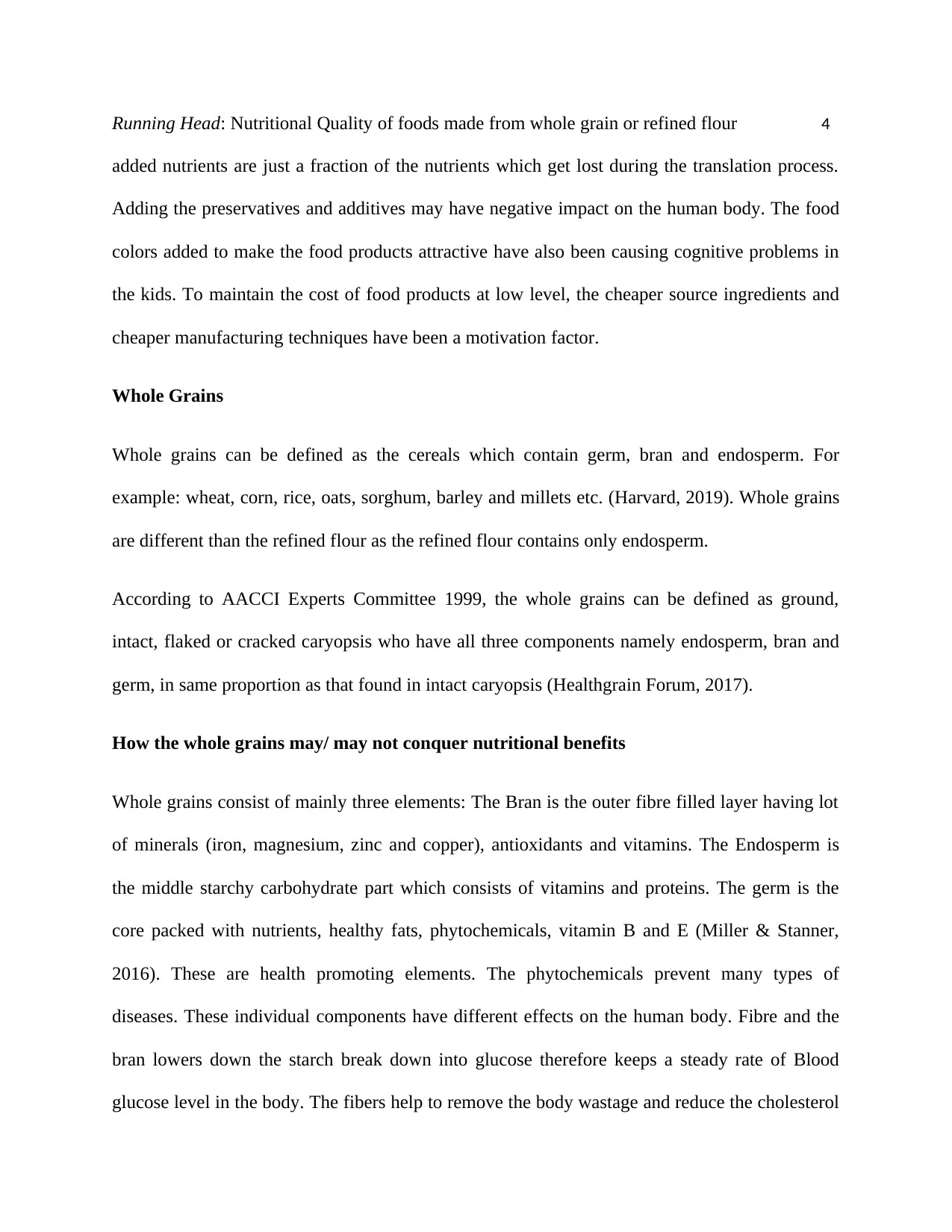
Running Head: Nutritional Quality of foods made from whole grain or refined flour 4
added nutrients are just a fraction of the nutrients which get lost during the translation process.
Adding the preservatives and additives may have negative impact on the human body. The food
colors added to make the food products attractive have also been causing cognitive problems in
the kids. To maintain the cost of food products at low level, the cheaper source ingredients and
cheaper manufacturing techniques have been a motivation factor.
Whole Grains
Whole grains can be defined as the cereals which contain germ, bran and endosperm. For
example: wheat, corn, rice, oats, sorghum, barley and millets etc. (Harvard, 2019). Whole grains
are different than the refined flour as the refined flour contains only endosperm.
According to AACCI Experts Committee 1999, the whole grains can be defined as ground,
intact, flaked or cracked caryopsis who have all three components namely endosperm, bran and
germ, in same proportion as that found in intact caryopsis (Healthgrain Forum, 2017).
How the whole grains may/ may not conquer nutritional benefits
Whole grains consist of mainly three elements: The Bran is the outer fibre filled layer having lot
of minerals (iron, magnesium, zinc and copper), antioxidants and vitamins. The Endosperm is
the middle starchy carbohydrate part which consists of vitamins and proteins. The germ is the
core packed with nutrients, healthy fats, phytochemicals, vitamin B and E (Miller & Stanner,
2016). These are health promoting elements. The phytochemicals prevent many types of
diseases. These individual components have different effects on the human body. Fibre and the
bran lowers down the starch break down into glucose therefore keeps a steady rate of Blood
glucose level in the body. The fibers help to remove the body wastage and reduce the cholesterol
added nutrients are just a fraction of the nutrients which get lost during the translation process.
Adding the preservatives and additives may have negative impact on the human body. The food
colors added to make the food products attractive have also been causing cognitive problems in
the kids. To maintain the cost of food products at low level, the cheaper source ingredients and
cheaper manufacturing techniques have been a motivation factor.
Whole Grains
Whole grains can be defined as the cereals which contain germ, bran and endosperm. For
example: wheat, corn, rice, oats, sorghum, barley and millets etc. (Harvard, 2019). Whole grains
are different than the refined flour as the refined flour contains only endosperm.
According to AACCI Experts Committee 1999, the whole grains can be defined as ground,
intact, flaked or cracked caryopsis who have all three components namely endosperm, bran and
germ, in same proportion as that found in intact caryopsis (Healthgrain Forum, 2017).
How the whole grains may/ may not conquer nutritional benefits
Whole grains consist of mainly three elements: The Bran is the outer fibre filled layer having lot
of minerals (iron, magnesium, zinc and copper), antioxidants and vitamins. The Endosperm is
the middle starchy carbohydrate part which consists of vitamins and proteins. The germ is the
core packed with nutrients, healthy fats, phytochemicals, vitamin B and E (Miller & Stanner,
2016). These are health promoting elements. The phytochemicals prevent many types of
diseases. These individual components have different effects on the human body. Fibre and the
bran lowers down the starch break down into glucose therefore keeps a steady rate of Blood
glucose level in the body. The fibers help to remove the body wastage and reduce the cholesterol
Paraphrase This Document
Need a fresh take? Get an instant paraphrase of this document with our AI Paraphraser
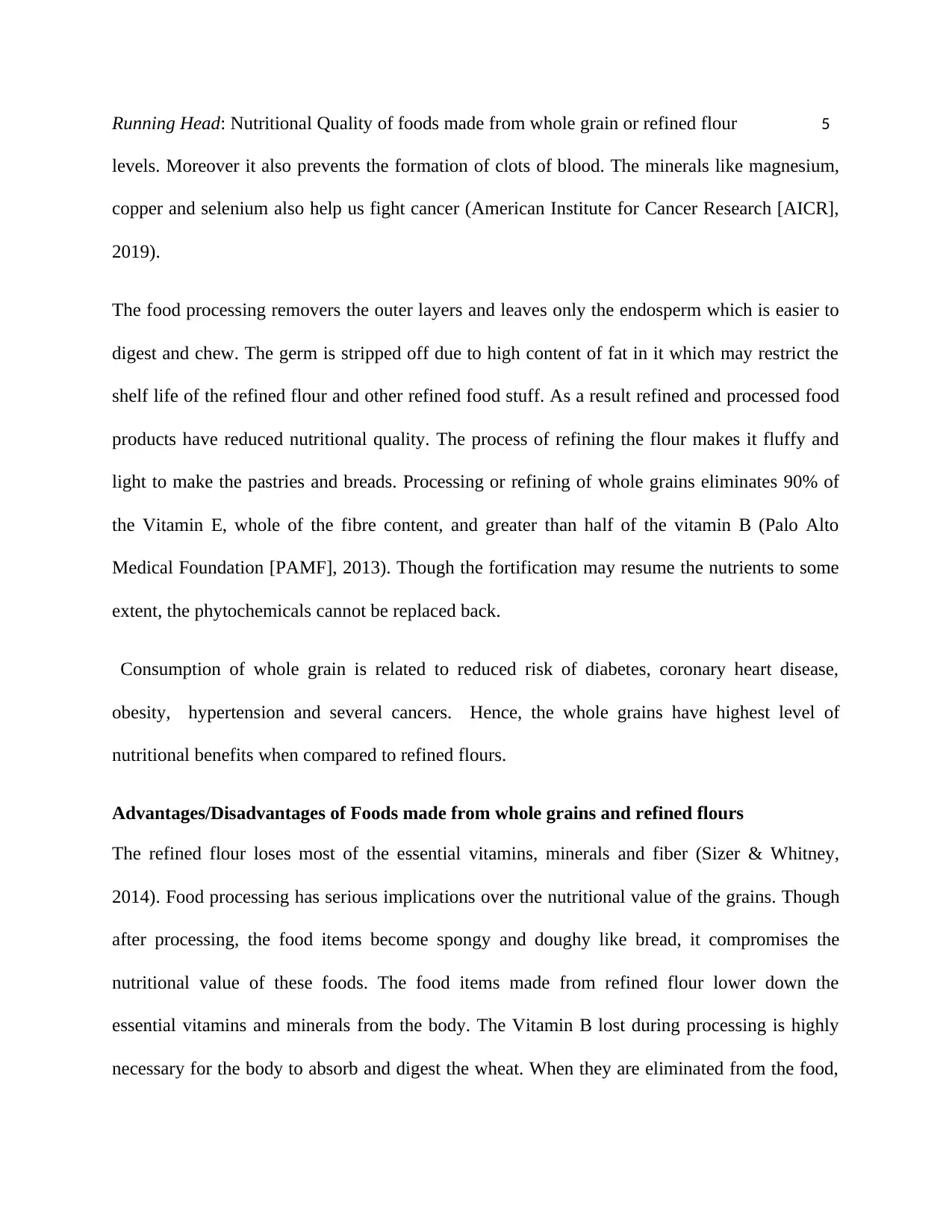
Running Head: Nutritional Quality of foods made from whole grain or refined flour 5
levels. Moreover it also prevents the formation of clots of blood. The minerals like magnesium,
copper and selenium also help us fight cancer (American Institute for Cancer Research [AICR],
2019).
The food processing removers the outer layers and leaves only the endosperm which is easier to
digest and chew. The germ is stripped off due to high content of fat in it which may restrict the
shelf life of the refined flour and other refined food stuff. As a result refined and processed food
products have reduced nutritional quality. The process of refining the flour makes it fluffy and
light to make the pastries and breads. Processing or refining of whole grains eliminates 90% of
the Vitamin E, whole of the fibre content, and greater than half of the vitamin B (Palo Alto
Medical Foundation [PAMF], 2013). Though the fortification may resume the nutrients to some
extent, the phytochemicals cannot be replaced back.
Consumption of whole grain is related to reduced risk of diabetes, coronary heart disease,
obesity, hypertension and several cancers. Hence, the whole grains have highest level of
nutritional benefits when compared to refined flours.
Advantages/Disadvantages of Foods made from whole grains and refined flours
The refined flour loses most of the essential vitamins, minerals and fiber (Sizer & Whitney,
2014). Food processing has serious implications over the nutritional value of the grains. Though
after processing, the food items become spongy and doughy like bread, it compromises the
nutritional value of these foods. The food items made from refined flour lower down the
essential vitamins and minerals from the body. The Vitamin B lost during processing is highly
necessary for the body to absorb and digest the wheat. When they are eliminated from the food,
levels. Moreover it also prevents the formation of clots of blood. The minerals like magnesium,
copper and selenium also help us fight cancer (American Institute for Cancer Research [AICR],
2019).
The food processing removers the outer layers and leaves only the endosperm which is easier to
digest and chew. The germ is stripped off due to high content of fat in it which may restrict the
shelf life of the refined flour and other refined food stuff. As a result refined and processed food
products have reduced nutritional quality. The process of refining the flour makes it fluffy and
light to make the pastries and breads. Processing or refining of whole grains eliminates 90% of
the Vitamin E, whole of the fibre content, and greater than half of the vitamin B (Palo Alto
Medical Foundation [PAMF], 2013). Though the fortification may resume the nutrients to some
extent, the phytochemicals cannot be replaced back.
Consumption of whole grain is related to reduced risk of diabetes, coronary heart disease,
obesity, hypertension and several cancers. Hence, the whole grains have highest level of
nutritional benefits when compared to refined flours.
Advantages/Disadvantages of Foods made from whole grains and refined flours
The refined flour loses most of the essential vitamins, minerals and fiber (Sizer & Whitney,
2014). Food processing has serious implications over the nutritional value of the grains. Though
after processing, the food items become spongy and doughy like bread, it compromises the
nutritional value of these foods. The food items made from refined flour lower down the
essential vitamins and minerals from the body. The Vitamin B lost during processing is highly
necessary for the body to absorb and digest the wheat. When they are eliminated from the food,
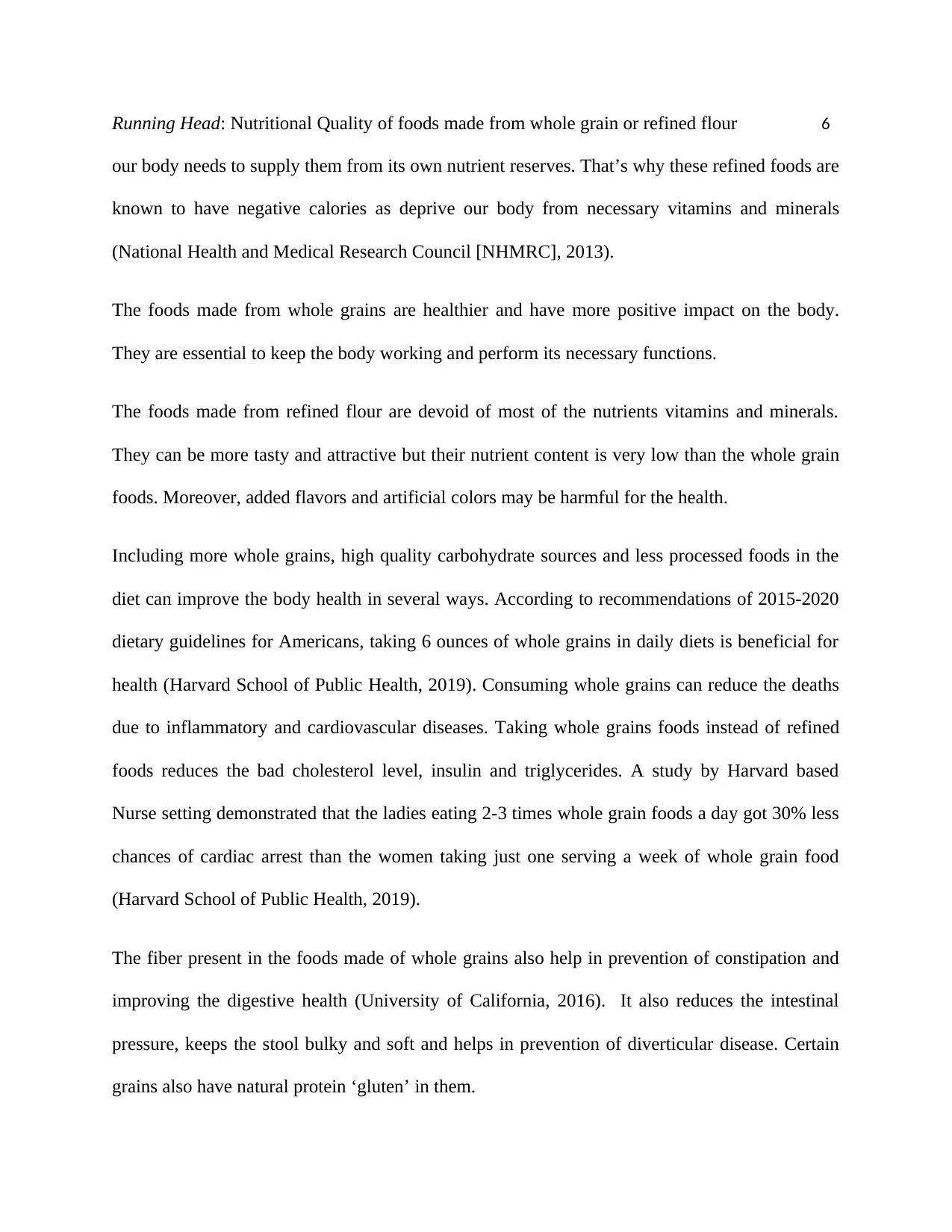
Running Head: Nutritional Quality of foods made from whole grain or refined flour 6
our body needs to supply them from its own nutrient reserves. That’s why these refined foods are
known to have negative calories as deprive our body from necessary vitamins and minerals
(National Health and Medical Research Council [NHMRC], 2013).
The foods made from whole grains are healthier and have more positive impact on the body.
They are essential to keep the body working and perform its necessary functions.
The foods made from refined flour are devoid of most of the nutrients vitamins and minerals.
They can be more tasty and attractive but their nutrient content is very low than the whole grain
foods. Moreover, added flavors and artificial colors may be harmful for the health.
Including more whole grains, high quality carbohydrate sources and less processed foods in the
diet can improve the body health in several ways. According to recommendations of 2015-2020
dietary guidelines for Americans, taking 6 ounces of whole grains in daily diets is beneficial for
health (Harvard School of Public Health, 2019). Consuming whole grains can reduce the deaths
due to inflammatory and cardiovascular diseases. Taking whole grains foods instead of refined
foods reduces the bad cholesterol level, insulin and triglycerides. A study by Harvard based
Nurse setting demonstrated that the ladies eating 2-3 times whole grain foods a day got 30% less
chances of cardiac arrest than the women taking just one serving a week of whole grain food
(Harvard School of Public Health, 2019).
The fiber present in the foods made of whole grains also help in prevention of constipation and
improving the digestive health (University of California, 2016). It also reduces the intestinal
pressure, keeps the stool bulky and soft and helps in prevention of diverticular disease. Certain
grains also have natural protein ‘gluten’ in them.
our body needs to supply them from its own nutrient reserves. That’s why these refined foods are
known to have negative calories as deprive our body from necessary vitamins and minerals
(National Health and Medical Research Council [NHMRC], 2013).
The foods made from whole grains are healthier and have more positive impact on the body.
They are essential to keep the body working and perform its necessary functions.
The foods made from refined flour are devoid of most of the nutrients vitamins and minerals.
They can be more tasty and attractive but their nutrient content is very low than the whole grain
foods. Moreover, added flavors and artificial colors may be harmful for the health.
Including more whole grains, high quality carbohydrate sources and less processed foods in the
diet can improve the body health in several ways. According to recommendations of 2015-2020
dietary guidelines for Americans, taking 6 ounces of whole grains in daily diets is beneficial for
health (Harvard School of Public Health, 2019). Consuming whole grains can reduce the deaths
due to inflammatory and cardiovascular diseases. Taking whole grains foods instead of refined
foods reduces the bad cholesterol level, insulin and triglycerides. A study by Harvard based
Nurse setting demonstrated that the ladies eating 2-3 times whole grain foods a day got 30% less
chances of cardiac arrest than the women taking just one serving a week of whole grain food
(Harvard School of Public Health, 2019).
The fiber present in the foods made of whole grains also help in prevention of constipation and
improving the digestive health (University of California, 2016). It also reduces the intestinal
pressure, keeps the stool bulky and soft and helps in prevention of diverticular disease. Certain
grains also have natural protein ‘gluten’ in them.
⊘ This is a preview!⊘
Do you want full access?
Subscribe today to unlock all pages.

Trusted by 1+ million students worldwide
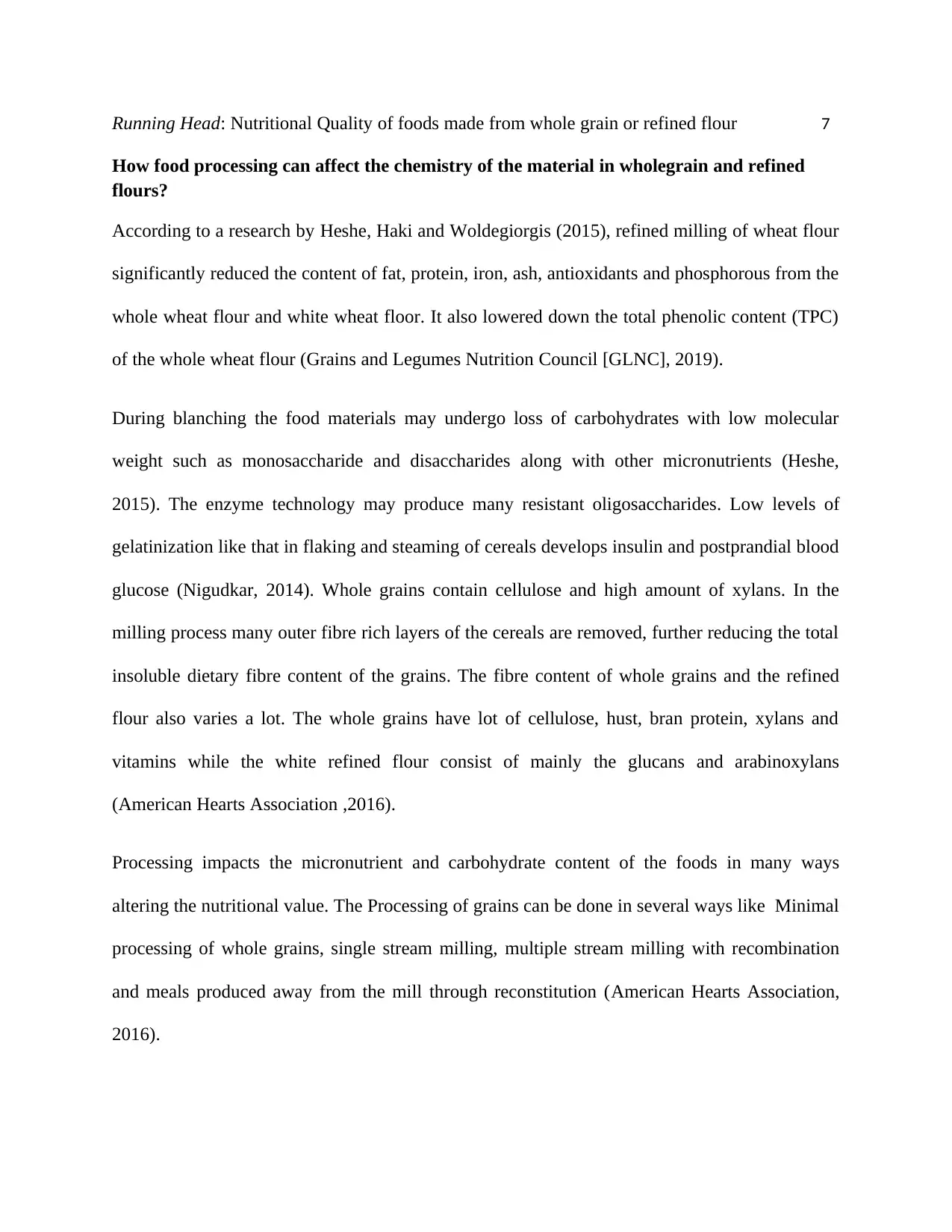
Running Head: Nutritional Quality of foods made from whole grain or refined flour 7
How food processing can affect the chemistry of the material in wholegrain and refined
flours?
According to a research by Heshe, Haki and Woldegiorgis (2015), refined milling of wheat flour
significantly reduced the content of fat, protein, iron, ash, antioxidants and phosphorous from the
whole wheat flour and white wheat floor. It also lowered down the total phenolic content (TPC)
of the whole wheat flour (Grains and Legumes Nutrition Council [GLNC], 2019).
During blanching the food materials may undergo loss of carbohydrates with low molecular
weight such as monosaccharide and disaccharides along with other micronutrients (Heshe,
2015). The enzyme technology may produce many resistant oligosaccharides. Low levels of
gelatinization like that in flaking and steaming of cereals develops insulin and postprandial blood
glucose (Nigudkar, 2014). Whole grains contain cellulose and high amount of xylans. In the
milling process many outer fibre rich layers of the cereals are removed, further reducing the total
insoluble dietary fibre content of the grains. The fibre content of whole grains and the refined
flour also varies a lot. The whole grains have lot of cellulose, hust, bran protein, xylans and
vitamins while the white refined flour consist of mainly the glucans and arabinoxylans
(American Hearts Association ,2016).
Processing impacts the micronutrient and carbohydrate content of the foods in many ways
altering the nutritional value. The Processing of grains can be done in several ways like Minimal
processing of whole grains, single stream milling, multiple stream milling with recombination
and meals produced away from the mill through reconstitution (American Hearts Association,
2016).
How food processing can affect the chemistry of the material in wholegrain and refined
flours?
According to a research by Heshe, Haki and Woldegiorgis (2015), refined milling of wheat flour
significantly reduced the content of fat, protein, iron, ash, antioxidants and phosphorous from the
whole wheat flour and white wheat floor. It also lowered down the total phenolic content (TPC)
of the whole wheat flour (Grains and Legumes Nutrition Council [GLNC], 2019).
During blanching the food materials may undergo loss of carbohydrates with low molecular
weight such as monosaccharide and disaccharides along with other micronutrients (Heshe,
2015). The enzyme technology may produce many resistant oligosaccharides. Low levels of
gelatinization like that in flaking and steaming of cereals develops insulin and postprandial blood
glucose (Nigudkar, 2014). Whole grains contain cellulose and high amount of xylans. In the
milling process many outer fibre rich layers of the cereals are removed, further reducing the total
insoluble dietary fibre content of the grains. The fibre content of whole grains and the refined
flour also varies a lot. The whole grains have lot of cellulose, hust, bran protein, xylans and
vitamins while the white refined flour consist of mainly the glucans and arabinoxylans
(American Hearts Association ,2016).
Processing impacts the micronutrient and carbohydrate content of the foods in many ways
altering the nutritional value. The Processing of grains can be done in several ways like Minimal
processing of whole grains, single stream milling, multiple stream milling with recombination
and meals produced away from the mill through reconstitution (American Hearts Association,
2016).
Paraphrase This Document
Need a fresh take? Get an instant paraphrase of this document with our AI Paraphraser
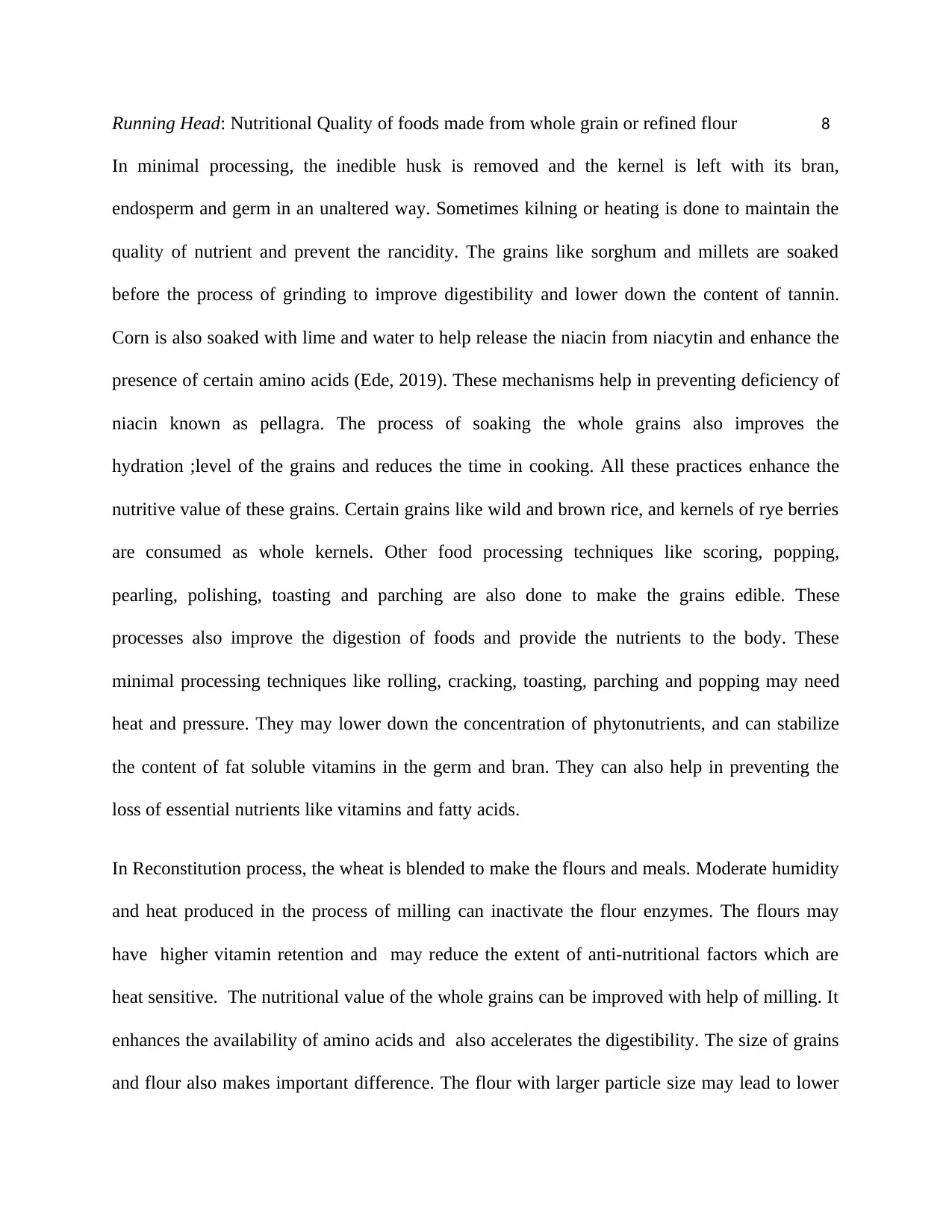
Running Head: Nutritional Quality of foods made from whole grain or refined flour 8
In minimal processing, the inedible husk is removed and the kernel is left with its bran,
endosperm and germ in an unaltered way. Sometimes kilning or heating is done to maintain the
quality of nutrient and prevent the rancidity. The grains like sorghum and millets are soaked
before the process of grinding to improve digestibility and lower down the content of tannin.
Corn is also soaked with lime and water to help release the niacin from niacytin and enhance the
presence of certain amino acids (Ede, 2019). These mechanisms help in preventing deficiency of
niacin known as pellagra. The process of soaking the whole grains also improves the
hydration ;level of the grains and reduces the time in cooking. All these practices enhance the
nutritive value of these grains. Certain grains like wild and brown rice, and kernels of rye berries
are consumed as whole kernels. Other food processing techniques like scoring, popping,
pearling, polishing, toasting and parching are also done to make the grains edible. These
processes also improve the digestion of foods and provide the nutrients to the body. These
minimal processing techniques like rolling, cracking, toasting, parching and popping may need
heat and pressure. They may lower down the concentration of phytonutrients, and can stabilize
the content of fat soluble vitamins in the germ and bran. They can also help in preventing the
loss of essential nutrients like vitamins and fatty acids.
In Reconstitution process, the wheat is blended to make the flours and meals. Moderate humidity
and heat produced in the process of milling can inactivate the flour enzymes. The flours may
have higher vitamin retention and may reduce the extent of anti-nutritional factors which are
heat sensitive. The nutritional value of the whole grains can be improved with help of milling. It
enhances the availability of amino acids and also accelerates the digestibility. The size of grains
and flour also makes important difference. The flour with larger particle size may lead to lower
In minimal processing, the inedible husk is removed and the kernel is left with its bran,
endosperm and germ in an unaltered way. Sometimes kilning or heating is done to maintain the
quality of nutrient and prevent the rancidity. The grains like sorghum and millets are soaked
before the process of grinding to improve digestibility and lower down the content of tannin.
Corn is also soaked with lime and water to help release the niacin from niacytin and enhance the
presence of certain amino acids (Ede, 2019). These mechanisms help in preventing deficiency of
niacin known as pellagra. The process of soaking the whole grains also improves the
hydration ;level of the grains and reduces the time in cooking. All these practices enhance the
nutritive value of these grains. Certain grains like wild and brown rice, and kernels of rye berries
are consumed as whole kernels. Other food processing techniques like scoring, popping,
pearling, polishing, toasting and parching are also done to make the grains edible. These
processes also improve the digestion of foods and provide the nutrients to the body. These
minimal processing techniques like rolling, cracking, toasting, parching and popping may need
heat and pressure. They may lower down the concentration of phytonutrients, and can stabilize
the content of fat soluble vitamins in the germ and bran. They can also help in preventing the
loss of essential nutrients like vitamins and fatty acids.
In Reconstitution process, the wheat is blended to make the flours and meals. Moderate humidity
and heat produced in the process of milling can inactivate the flour enzymes. The flours may
have higher vitamin retention and may reduce the extent of anti-nutritional factors which are
heat sensitive. The nutritional value of the whole grains can be improved with help of milling. It
enhances the availability of amino acids and also accelerates the digestibility. The size of grains
and flour also makes important difference. The flour with larger particle size may lead to lower
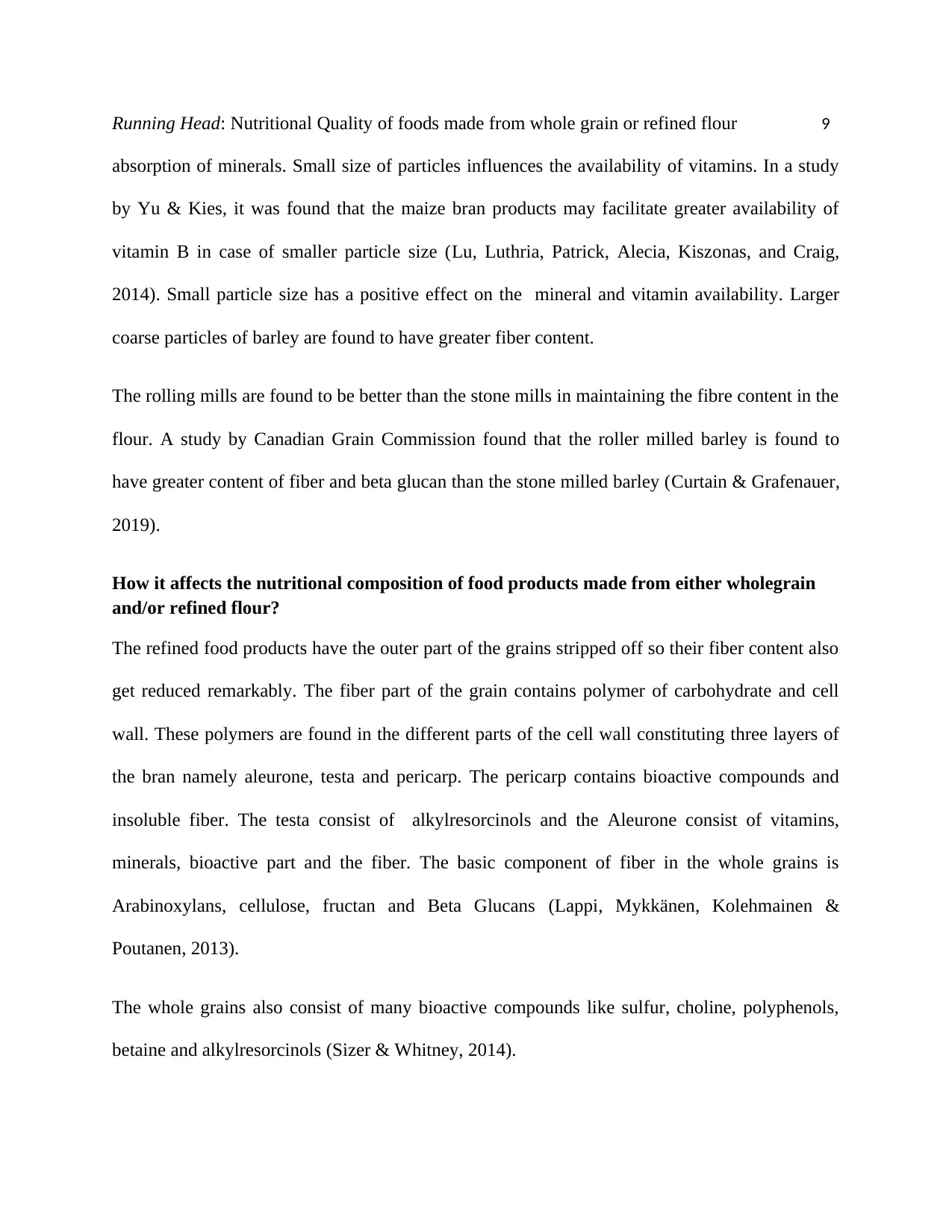
Running Head: Nutritional Quality of foods made from whole grain or refined flour 9
absorption of minerals. Small size of particles influences the availability of vitamins. In a study
by Yu & Kies, it was found that the maize bran products may facilitate greater availability of
vitamin B in case of smaller particle size (Lu, Luthria, Patrick, Alecia, Kiszonas, and Craig,
2014). Small particle size has a positive effect on the mineral and vitamin availability. Larger
coarse particles of barley are found to have greater fiber content.
The rolling mills are found to be better than the stone mills in maintaining the fibre content in the
flour. A study by Canadian Grain Commission found that the roller milled barley is found to
have greater content of fiber and beta glucan than the stone milled barley (Curtain & Grafenauer,
2019).
How it affects the nutritional composition of food products made from either wholegrain
and/or refined flour?
The refined food products have the outer part of the grains stripped off so their fiber content also
get reduced remarkably. The fiber part of the grain contains polymer of carbohydrate and cell
wall. These polymers are found in the different parts of the cell wall constituting three layers of
the bran namely aleurone, testa and pericarp. The pericarp contains bioactive compounds and
insoluble fiber. The testa consist of alkylresorcinols and the Aleurone consist of vitamins,
minerals, bioactive part and the fiber. The basic component of fiber in the whole grains is
Arabinoxylans, cellulose, fructan and Beta Glucans (Lappi, Mykkänen, Kolehmainen &
Poutanen, 2013).
The whole grains also consist of many bioactive compounds like sulfur, choline, polyphenols,
betaine and alkylresorcinols (Sizer & Whitney, 2014).
absorption of minerals. Small size of particles influences the availability of vitamins. In a study
by Yu & Kies, it was found that the maize bran products may facilitate greater availability of
vitamin B in case of smaller particle size (Lu, Luthria, Patrick, Alecia, Kiszonas, and Craig,
2014). Small particle size has a positive effect on the mineral and vitamin availability. Larger
coarse particles of barley are found to have greater fiber content.
The rolling mills are found to be better than the stone mills in maintaining the fibre content in the
flour. A study by Canadian Grain Commission found that the roller milled barley is found to
have greater content of fiber and beta glucan than the stone milled barley (Curtain & Grafenauer,
2019).
How it affects the nutritional composition of food products made from either wholegrain
and/or refined flour?
The refined food products have the outer part of the grains stripped off so their fiber content also
get reduced remarkably. The fiber part of the grain contains polymer of carbohydrate and cell
wall. These polymers are found in the different parts of the cell wall constituting three layers of
the bran namely aleurone, testa and pericarp. The pericarp contains bioactive compounds and
insoluble fiber. The testa consist of alkylresorcinols and the Aleurone consist of vitamins,
minerals, bioactive part and the fiber. The basic component of fiber in the whole grains is
Arabinoxylans, cellulose, fructan and Beta Glucans (Lappi, Mykkänen, Kolehmainen &
Poutanen, 2013).
The whole grains also consist of many bioactive compounds like sulfur, choline, polyphenols,
betaine and alkylresorcinols (Sizer & Whitney, 2014).
⊘ This is a preview!⊘
Do you want full access?
Subscribe today to unlock all pages.

Trusted by 1+ million students worldwide
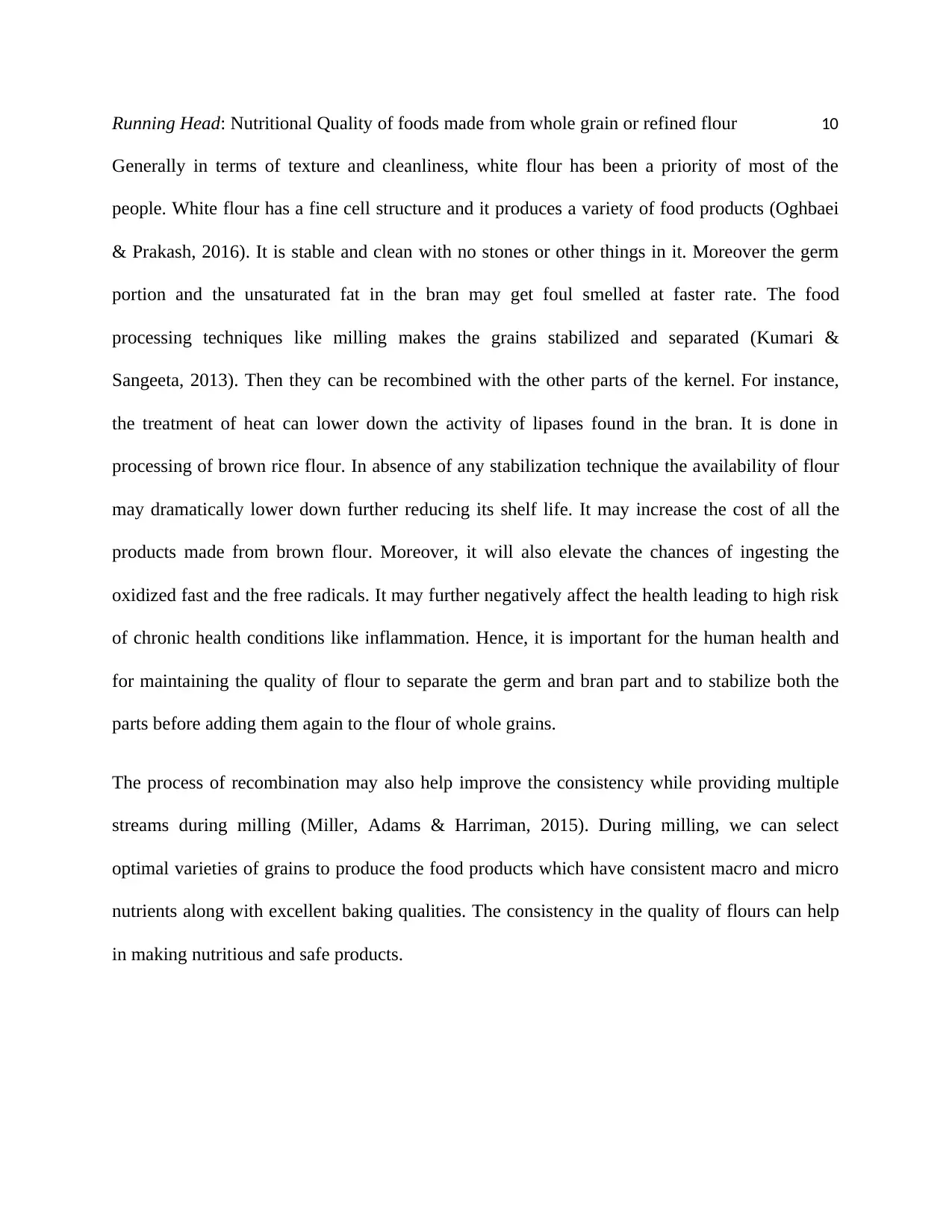
Running Head: Nutritional Quality of foods made from whole grain or refined flour 10
Generally in terms of texture and cleanliness, white flour has been a priority of most of the
people. White flour has a fine cell structure and it produces a variety of food products (Oghbaei
& Prakash, 2016). It is stable and clean with no stones or other things in it. Moreover the germ
portion and the unsaturated fat in the bran may get foul smelled at faster rate. The food
processing techniques like milling makes the grains stabilized and separated (Kumari &
Sangeeta, 2013). Then they can be recombined with the other parts of the kernel. For instance,
the treatment of heat can lower down the activity of lipases found in the bran. It is done in
processing of brown rice flour. In absence of any stabilization technique the availability of flour
may dramatically lower down further reducing its shelf life. It may increase the cost of all the
products made from brown flour. Moreover, it will also elevate the chances of ingesting the
oxidized fast and the free radicals. It may further negatively affect the health leading to high risk
of chronic health conditions like inflammation. Hence, it is important for the human health and
for maintaining the quality of flour to separate the germ and bran part and to stabilize both the
parts before adding them again to the flour of whole grains.
The process of recombination may also help improve the consistency while providing multiple
streams during milling (Miller, Adams & Harriman, 2015). During milling, we can select
optimal varieties of grains to produce the food products which have consistent macro and micro
nutrients along with excellent baking qualities. The consistency in the quality of flours can help
in making nutritious and safe products.
Generally in terms of texture and cleanliness, white flour has been a priority of most of the
people. White flour has a fine cell structure and it produces a variety of food products (Oghbaei
& Prakash, 2016). It is stable and clean with no stones or other things in it. Moreover the germ
portion and the unsaturated fat in the bran may get foul smelled at faster rate. The food
processing techniques like milling makes the grains stabilized and separated (Kumari &
Sangeeta, 2013). Then they can be recombined with the other parts of the kernel. For instance,
the treatment of heat can lower down the activity of lipases found in the bran. It is done in
processing of brown rice flour. In absence of any stabilization technique the availability of flour
may dramatically lower down further reducing its shelf life. It may increase the cost of all the
products made from brown flour. Moreover, it will also elevate the chances of ingesting the
oxidized fast and the free radicals. It may further negatively affect the health leading to high risk
of chronic health conditions like inflammation. Hence, it is important for the human health and
for maintaining the quality of flour to separate the germ and bran part and to stabilize both the
parts before adding them again to the flour of whole grains.
The process of recombination may also help improve the consistency while providing multiple
streams during milling (Miller, Adams & Harriman, 2015). During milling, we can select
optimal varieties of grains to produce the food products which have consistent macro and micro
nutrients along with excellent baking qualities. The consistency in the quality of flours can help
in making nutritious and safe products.
Paraphrase This Document
Need a fresh take? Get an instant paraphrase of this document with our AI Paraphraser
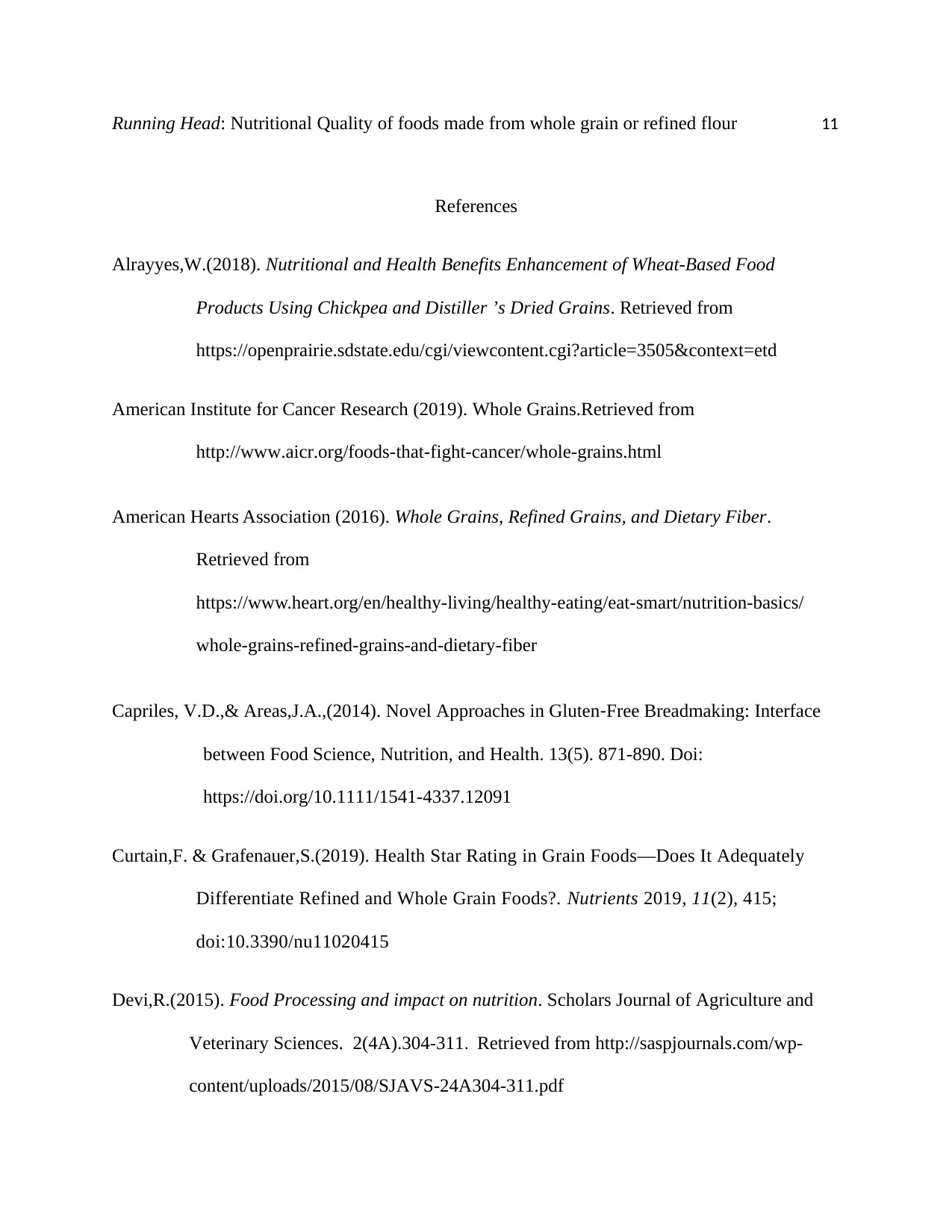
Running Head: Nutritional Quality of foods made from whole grain or refined flour 11
References
Alrayyes,W.(2018). Nutritional and Health Benefits Enhancement of Wheat-Based Food
Products Using Chickpea and Distiller ’s Dried Grains. Retrieved from
https://openprairie.sdstate.edu/cgi/viewcontent.cgi?article=3505&context=etd
American Institute for Cancer Research (2019). Whole Grains.Retrieved from
http://www.aicr.org/foods-that-fight-cancer/whole-grains.html
American Hearts Association (2016). Whole Grains, Refined Grains, and Dietary Fiber.
Retrieved from
https://www.heart.org/en/healthy-living/healthy-eating/eat-smart/nutrition-basics/
whole-grains-refined-grains-and-dietary-fiber
Capriles, V.D.,& Areas,J.A.,(2014). Novel Approaches in Gluten‐Free Breadmaking: Interface
between Food Science, Nutrition, and Health. 13(5). 871-890. Doi:
https://doi.org/10.1111/1541-4337.12091
Curtain,F. & Grafenauer,S.(2019). Health Star Rating in Grain Foods—Does It Adequately
Differentiate Refined and Whole Grain Foods?. Nutrients 2019, 11(2), 415;
doi:10.3390/nu11020415
Devi,R.(2015). Food Processing and impact on nutrition. Scholars Journal of Agriculture and
Veterinary Sciences. 2(4A).304-311. Retrieved from http://saspjournals.com/wp-
content/uploads/2015/08/SJAVS-24A304-311.pdf
References
Alrayyes,W.(2018). Nutritional and Health Benefits Enhancement of Wheat-Based Food
Products Using Chickpea and Distiller ’s Dried Grains. Retrieved from
https://openprairie.sdstate.edu/cgi/viewcontent.cgi?article=3505&context=etd
American Institute for Cancer Research (2019). Whole Grains.Retrieved from
http://www.aicr.org/foods-that-fight-cancer/whole-grains.html
American Hearts Association (2016). Whole Grains, Refined Grains, and Dietary Fiber.
Retrieved from
https://www.heart.org/en/healthy-living/healthy-eating/eat-smart/nutrition-basics/
whole-grains-refined-grains-and-dietary-fiber
Capriles, V.D.,& Areas,J.A.,(2014). Novel Approaches in Gluten‐Free Breadmaking: Interface
between Food Science, Nutrition, and Health. 13(5). 871-890. Doi:
https://doi.org/10.1111/1541-4337.12091
Curtain,F. & Grafenauer,S.(2019). Health Star Rating in Grain Foods—Does It Adequately
Differentiate Refined and Whole Grain Foods?. Nutrients 2019, 11(2), 415;
doi:10.3390/nu11020415
Devi,R.(2015). Food Processing and impact on nutrition. Scholars Journal of Agriculture and
Veterinary Sciences. 2(4A).304-311. Retrieved from http://saspjournals.com/wp-
content/uploads/2015/08/SJAVS-24A304-311.pdf
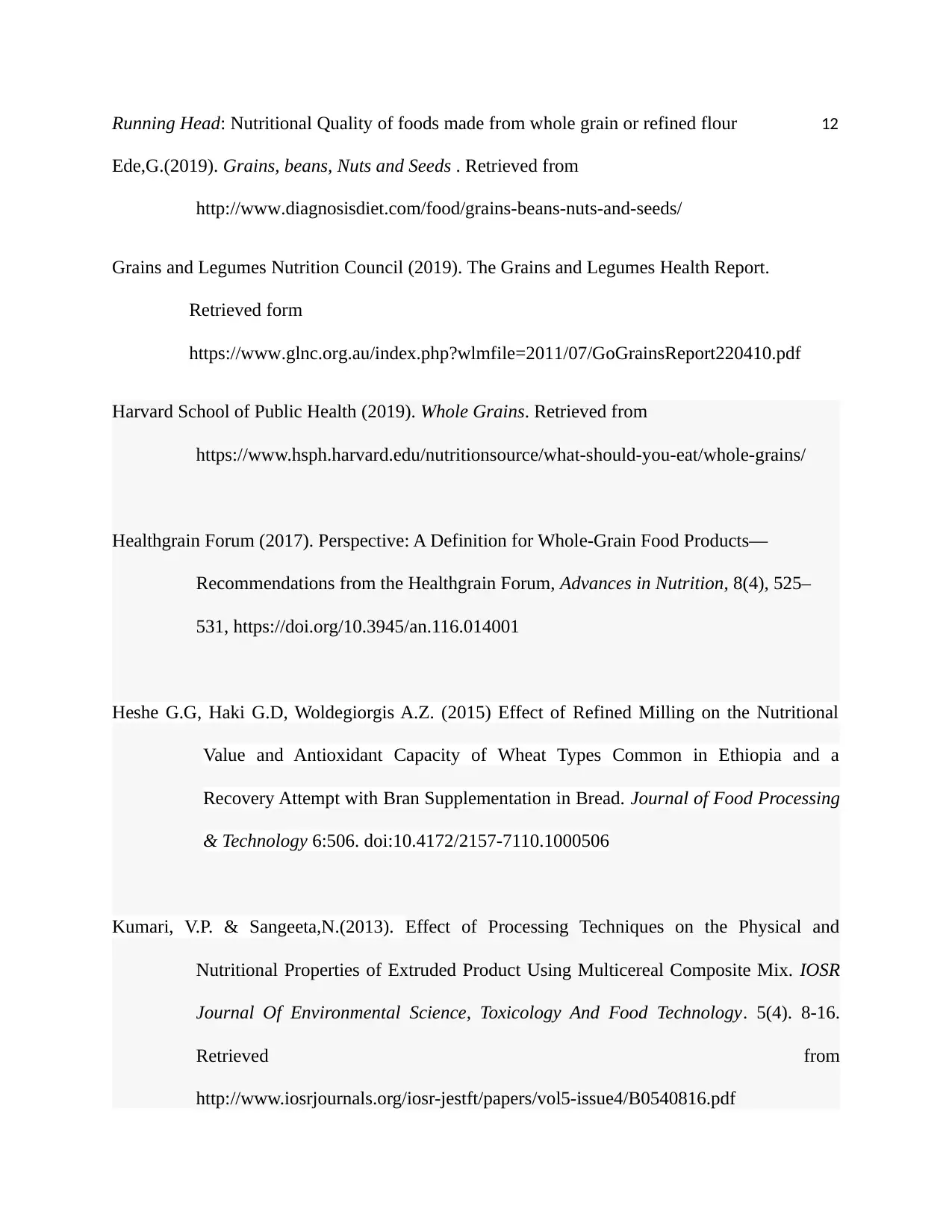
Running Head: Nutritional Quality of foods made from whole grain or refined flour 12
Ede,G.(2019). Grains, beans, Nuts and Seeds . Retrieved from
http://www.diagnosisdiet.com/food/grains-beans-nuts-and-seeds/
Grains and Legumes Nutrition Council (2019). The Grains and Legumes Health Report.
Retrieved form
https://www.glnc.org.au/index.php?wlmfile=2011/07/GoGrainsReport220410.pdf
Harvard School of Public Health (2019). Whole Grains. Retrieved from
https://www.hsph.harvard.edu/nutritionsource/what-should-you-eat/whole-grains/
Healthgrain Forum (2017). Perspective: A Definition for Whole-Grain Food Products—
Recommendations from the Healthgrain Forum, Advances in Nutrition, 8(4), 525–
531, https://doi.org/10.3945/an.116.014001
Heshe G.G, Haki G.D, Woldegiorgis A.Z. (2015) Effect of Refined Milling on the Nutritional
Value and Antioxidant Capacity of Wheat Types Common in Ethiopia and a
Recovery Attempt with Bran Supplementation in Bread. Journal of Food Processing
& Technology 6:506. doi:10.4172/2157-7110.1000506
Kumari, V.P. & Sangeeta,N.(2013). Effect of Processing Techniques on the Physical and
Nutritional Properties of Extruded Product Using Multicereal Composite Mix. IOSR
Journal Of Environmental Science, Toxicology And Food Technology. 5(4). 8-16.
Retrieved from
http://www.iosrjournals.org/iosr-jestft/papers/vol5-issue4/B0540816.pdf
Ede,G.(2019). Grains, beans, Nuts and Seeds . Retrieved from
http://www.diagnosisdiet.com/food/grains-beans-nuts-and-seeds/
Grains and Legumes Nutrition Council (2019). The Grains and Legumes Health Report.
Retrieved form
https://www.glnc.org.au/index.php?wlmfile=2011/07/GoGrainsReport220410.pdf
Harvard School of Public Health (2019). Whole Grains. Retrieved from
https://www.hsph.harvard.edu/nutritionsource/what-should-you-eat/whole-grains/
Healthgrain Forum (2017). Perspective: A Definition for Whole-Grain Food Products—
Recommendations from the Healthgrain Forum, Advances in Nutrition, 8(4), 525–
531, https://doi.org/10.3945/an.116.014001
Heshe G.G, Haki G.D, Woldegiorgis A.Z. (2015) Effect of Refined Milling on the Nutritional
Value and Antioxidant Capacity of Wheat Types Common in Ethiopia and a
Recovery Attempt with Bran Supplementation in Bread. Journal of Food Processing
& Technology 6:506. doi:10.4172/2157-7110.1000506
Kumari, V.P. & Sangeeta,N.(2013). Effect of Processing Techniques on the Physical and
Nutritional Properties of Extruded Product Using Multicereal Composite Mix. IOSR
Journal Of Environmental Science, Toxicology And Food Technology. 5(4). 8-16.
Retrieved from
http://www.iosrjournals.org/iosr-jestft/papers/vol5-issue4/B0540816.pdf
⊘ This is a preview!⊘
Do you want full access?
Subscribe today to unlock all pages.

Trusted by 1+ million students worldwide
1 out of 15
Your All-in-One AI-Powered Toolkit for Academic Success.
+13062052269
info@desklib.com
Available 24*7 on WhatsApp / Email
![[object Object]](/_next/static/media/star-bottom.7253800d.svg)
Unlock your academic potential
Copyright © 2020–2025 A2Z Services. All Rights Reserved. Developed and managed by ZUCOL.
